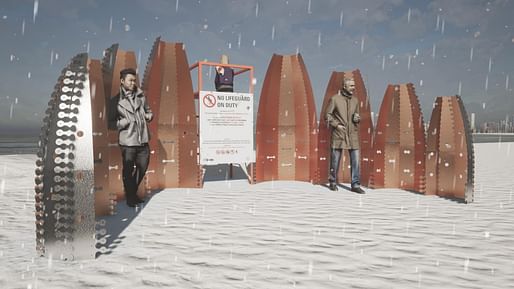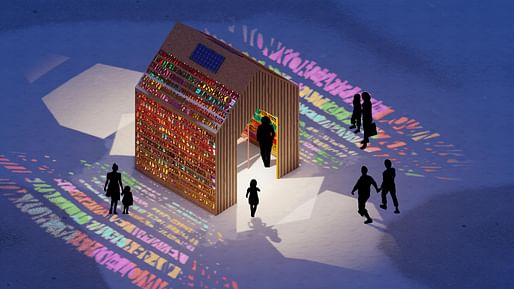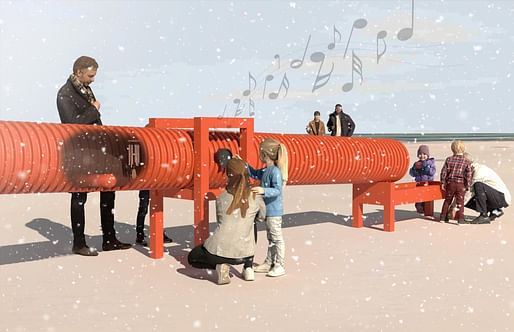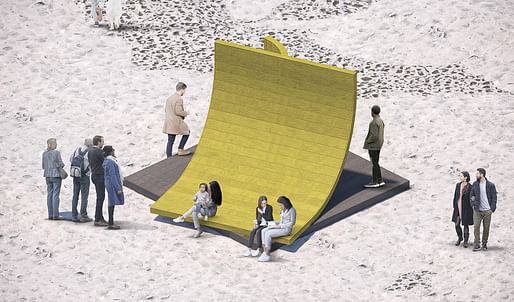
The winning entries for Toronto’s annual Winter Stations competition have been announced. Eight standout designs were selected for the competition’s 2023 edition. Since the competition's launch in 2014, it has welcomed colorful designs from a total of 90 different countries fostering tourism to the city’s otherwise out-of-use beaches. Winning designs have transformed Woodbine Beach’s lifeguard stations into works of art for public consumption and brought much-needed color into Toronto’s otherwise dreariest months.
The competition was founded as a collaboration between RAW Design, Ferris + Associates, and Curio. Toronto Metropolitan University, The University of Waterloo School of Architecture, and the University of Guelph are the educational partners behind this year’s event. Each station will be on view from February 20, 2023 onward.
View this year's winning designs below.

Ripple Hut by Toronto Metropolitan University team: Cesar Rodriguez Perfetti, Jake Kroft, Breno Gualter, and Dean Roumanis - Lead by Associate professor Vincent Hui (Canada)
Description: "Canoes have been a fundamental method of transportation for thousands of years. They have contributed immensely to humanity’s growth, inner strength, and freedom. Ripple Hut emulates the form of aggregated canoes and offers an alternative approach to the beauty and craft of canoe fabrication. The structural connections of the pavilion depict ripples in the water. Small apertures in the framework of the pavilion will provide framed views of the surrounding context while the composition of the shells will protect visitors from the harsh winter conditions." Read more here.

CONRAD by Novak Djogo & Daniel Joshua Vanderhorst (Canada)
Description: "Conrad was the name of a raccoon that died on the corner of Yonge and Church in the summer of 2015. And though Conrad was just a raccoon, he was human enough to inspire compassion and warmth in the hearts of Torontonians. This is a monument in his honor." Read more here.

the (Home) by Scott Shields Architects (Canada)
Description: "With the world moving through major economic and political changes while still recovering from years of pandemic, we imagine the best manifestation of this year’s theme of radiance in a simple definition of “Home”. Home, whether it’s a space or beloved neighbourhood, is a place blessed, where one feels security, strength and freedom thus casting a radiance of inner beauty and potential to the outside world." Read more here.

LIFE LINE by WeatherstonBruer Associates: James Bruer, Nick Roland, and Jacqueline Hampshire (Canada)
Description: "Radiance is a collective experience. The act of emitting and receiving positivity has an impact that reaches far beyond its origin point. LIFE LINE proposes an interactive station that materializes the transfer of joy through a shared, auditory experience. LIFE LINE references the built infrastructure of the waterfront, the linear landscape of the beach, and the distant horizon line. Participants can place a ball at the top of the tube and send it rolling through a series of wind chimes, creating a captivating soundscape for others to enjoy." Read more here.

3 Surfaces Pavilion by S-AR: Cesar Guerrero, Ana Cecilia Garza, and Orlando Garcia (Mexico)
Description: "Three surfaces form this pavilion. The first is a pavement that marks the area on which the other two surfaces are placed. The other two surfaces, one smaller than the other, are curved pieces that take advantage of their shapes to structure itself and, at the same time, open up possibilities for in habitability or programs. The user can gather around or inside the pavilion, stand, sit, or lie on the surfaces that call to be inhabited in very different ways." Read more here.

Delighthouse by Nick Green & Greig Pirrie (United Kingdom)
Description: "As though the winter sun has split through the prisms of an icy sky, rays of color fold around a timber tower standing proudly in the distance. Inspired by lighthouses in coastal settings across Canada and beyond, Delighthouse is a self-assured landmark guiding visitors to approach. While traditionally lighthouses are warnings, this installation is a welcoming beacon of hope, fun, energy, and pride. The confident and colorful pattern, evoking a sense of play, casts onto ground panels radiating out from the tower to embrace visitors. Scaled to house the lifeguard stand, the tower is clad in painted timber boards. Structurally, eight tapered timber frames lean inwards, joined to form the tower, with strength derived from each part coming together as a whole." Read more here.
![We[AR]. Image courtesy of Winter Stations competition. We[AR]. Image courtesy of Winter Stations competition.](https://archinect.gumlet.io/uploads/v6/v6bzl1n2v2yjqqsn.jpg?fit=crop&auto=compress%2Cformat&enlarge=true&w=514)
We[AR] by the University of Waterloo: Saina Amin, Craig Klomp, Lauren Mac Isaac, Catherine Yan (Design team), Mahmoud Afshari, Kaveh Eshraghian, and Roozbeh Moayedian (Tech team) - Lead by Assistant Professor Afshin Asari (Canada)
Description: We[AR] encourages connection, humanism, and the strength of living in community by demonstrating the power that can be achieved when a community pulls together. WE[AR] is an interactive virtual installation that considers the local and regional contexts in which it is shown to present social issues and it exemplifies the power of unity in the face of societal crises. Whether it is in Canada, the United States, Ukraine, Africa, Iran, Afghanistan or anywhere in the world it demonstrates the strength of solidarity in addressing social challenges. Human rights, women’s rights, LGBTQ2S+ rights, pay disparity, mental health, racial discrimination, and sexual violence are among the issues addressed." Read more here.

Winter-net by the University of Waterloo: Chiun Lee, Diana Si, Justin Park, Razmig Garboushian, Likhitha Varikuti, Simon Liao; Faculty Supervisors: David Correa, Fiona Lim Tung
Description: "Freshly fallen snow is typically seen as a blank canvas waiting for humans and animals to leave their mark on it. Winter-net looks to instead utilize snow’s ability to stick to porous surfaces as an ink for creative expression. Radiating from a central lifeguard stand, a series of layered nets woven between a structure of wooden posts filter and catch snow and sand over time as they are carried along by the wind. This accumulation inhibits light filtration and creates distinct shadows. While walking through Winter-net, participants are encouraged to interact with the nets in a similar way by covering them with snow to create a variety of forms and light conditions throughout." Read more here.
Read more about this year's winning design projects here.

The 2025 AZ Awards
Register/Submit by Fri, Feb 21, 2025

Museum of Emotions / Edition #6
Register by Thu, Jan 23, 2025
Submit by Tue, Apr 29, 2025

Ceramics of Italy Tile Competition
Register/Submit by Fri, Feb 14, 2025

Design and Build Student Competition- "Sacred Geometry: Platonic Solids"
Register/Submit by Sat, Apr 19, 2025
No Comments